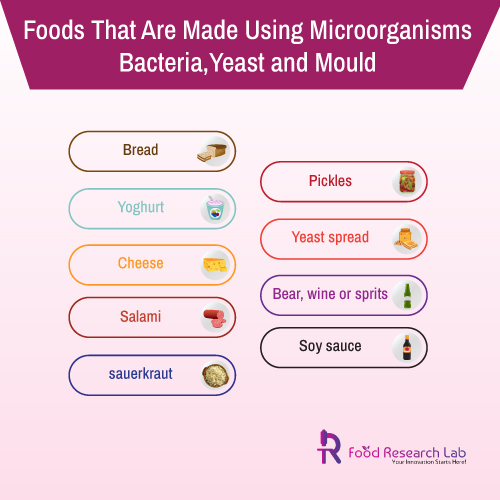
Principal Microbes Used in the Food and Beverage Industry
Major Microorganisms Utilized In The Food And Beverage Sector
In the food sector, microorganisms play a significant role and help to solve the challenges in the food and beverage industry. They’re utilized to create a variety of foods, and they’re also to blame for food rotting, which leads to poisoning and sickness. Microbial contamination of food items occurs most commonly on the journey from the farm to the processing facility, during processing, storage, transportation, distribution, and before consumption.
Microorganisms and their Applications in the Food Industry
There are currently around 3500 traditional fermented foods available around the globe. The food and beverage industries post covid-19 has changed a lot, especially in the usage of micro-organisms for food production.They come from animals or plants and are a part of our daily lives. Fermented drinks are not limited to alcoholic beverages; following harvest, cocoa beans, coffee grains, and tea leaves are fermented to acquire distinct flavours.

Bacteria
Bacteria are the most common single-celled bacteria. Cocci, or spherical cells; bacilli, or cylindrical or rod-shaped cells; and spiral or curved forms are the three types of therapeutically relevant bacteria. Although most pathogenic or disease-causing bacteria are gramme negative, three gram-positive rods have been linked to food poisoning: Bacillus cereus, Clostridium botulinum, and Clostridium perfringens. Some of the other most common bacteria causing food spoilage, infections and disease are Acinetobacter, Aeromonas, Escherichia, Proteus, Alcaligenes, Flavobacterium, Pseudomonas, Arcobacter, Salmonella, Lactococcus, Serratia, Campylobacter, Shigella, Citrobacter, Listeria, Staphylococcus, Micrococcus, Corynebacterium, Vibrio Enterobacter, Paenibacillus, Weissella, Enterococcus, Yersinia Different strains of bacteria are also used to produce various food and dairy products. Streptococcus, Lactobacillus Bifidobacterium, Erwinia, and other bacteria strains are utilized to make fermented foods and dairy products. Yoghurt is made from Streptococcus thermophilus and Lactobacillus bulgaricus bacteria.
Moulds
Moulds are multicellular filamentous fungi that may be identified by their fuzzy or cottony appearance when growing on food. They are mostly responsible for food spoiling at room temperature, between 25 and 30 degrees Celsius, with a low pH and low moisture. When grains and corns are kept in damp circumstances, mould can quickly form. Moulds develop on the surface of tainted food because they need free air to increase.
Moulds are also used in the production of various meals and food items. They are used to ripen a variety of foods, including cheese (e.g. Roquefort, Camembert). Moulds are also used to manufacture enzymes like amylase, which is needed to make bread, and citric acid, used in soft drinks. Moulds play an important role in the ripening of many Asian foods. Botrytis cinerea is a fungus that aids in the rotting of grapes to create wine. Lactic fermentation with mould produces viili, a distinctive Finnish fermented milk.
Yeasts
Yeasts are commonly employed in the food industry because they can ferment carbohydrates into ethanol and carbon dioxide. The most often used yeast, baker’s yeast, is produced industrially, and Saccharomyces carlsbergensis is the most common yeast used in beer production. Other notable yeast strains include Brettanomyces, Schizosaccharomyces, Candida, Cryptococcus, Debaryomyces, Zygosaccharomyces, Hanseniaspora, and Saccharomyces.
Factors Affecting Microorganism Growth
Food and beverage industry consultants state that it is critical to understand how to employ microorganisms in the food sector to comprehend their applications. Microorganisms behave differently in different settings and habitats.
- Trimming, cleaning, heating, and pickling are all methods for removing or killing them.
- Substances like acid or alcohol are added to develop organisms, or competition is encouraged.
- Contamination from raw or unprocessed food, people, equipment, and the environment is kept to a minimum.
- Cleaning and sanitizing the equipment to reduce microbial growth (container etc.).
- The pH of storage, light penetration, temperature, and other environmental parameters may all be adjusted.
- Although each of these elements impacting development can occur independently, in nature, they may occur concurrently. The inhibitory effects of many conditions that are relatively detrimental to microbial growth are cumulative.
Food Research Lab Offerings
Food Research Lab comprises a team of food microbiologists, food technologists, formulation scientists,food product developers and culinary experts who can develop your food products and conduct several tests for launch in the market. The shelf life of the products can be enhanced using microbial study, and the organoleptic properties can be amplified.






